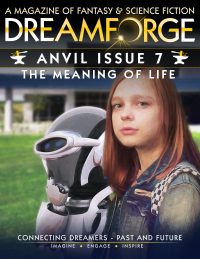 DreamForge Anvil #7, Spring 2022
DreamForge Anvil #7, Spring 2022
“The Hole in the Hedge” by Tammy Komoff
“The Sweet Apocalypse Travelling Medicine Show & Gypsy Caravan” by Grant Carrington
“The Peculiar Constraints of Peacetime” by Michael Zahniser
“A Properly Spiced Gingerbread” by David Hankins
“The Meaning of Life” by C.J. Peterson
“One Shot at Aeden” by Crystal Crawford
“Love in the Time of Con Crud” by Elena Pavlova (reprint, not reviewed)
“Between Oak and Acorn, a Sunset Waits” by Marisca Pichette
Reviewed by Victoria Silverwolf
Seven new stories appear in this issue, ranging from contemporary fantasy to science fiction set in deep space in the far future.
In “The Hole in the Hedge” by Tammy Komoff, a little girl travels into various versions of her adult life, either tragic or happy. Her mother carries her back into childhood each time, but realizes that she cannot hold on to her forever.
This brief tale is clearly intended as an allegory for parents’ worries about their children’s futures, and the reluctance to allow them to become independent. Those who have young children are likely to identify with the narrator’s concern for her daughter. Some readers may find it overly sentimental.
“The Sweet Apocalypse Travelling Medicine Show & Gypsy Caravan” by Grant Carrington features a troupe of entertainers who get into legal trouble when a fight breaks out during one of their shows at an isolated location. They have to figure out a way to preserve their reputation as respectable showfolk while appeasing the local residents.
I have deliberately avoided mentioning any science fiction content, because the basic plot could easily take place in any backwater town on Earth. In fact, the group journeys by starship from planet to planet, and the narrative is full of futuristic technology. The main appeal of this story is its detailed and convincing portrait of the lives of theater workers.
In “The Peculiar Constraints of Peacetime” by Michael Zahniser, a robot that formerly served in battle now acts as the guardian of a schoolgirl. The machine tries to protect her from bullies while experiencing memories of war.
The premise can be interpreted as a metaphor for a veteran suffering from post-traumatic stress disorder with flashbacks. The robot is an appealing character, but may be too anthropomorphized to be completely believable as a machine.
“A Properly Spiced Gingerbread” by David Hankins is a variation on the familiar story of the gingerbread man that adds horror and humor to the mix. A young woman inadvertently brings the sinister cookie to life, and has to figure out a way to prevent him from starting a reign of terror from her kitchen. This is a story best described as cute, and may be best suited for younger readers.
“The Meaning of Life” by C.J. Peterson takes place aboard a generation ship headed for a distant planet. The characters, grown from embryos, are now teenagers, about to undertake their adult roles on the ship. When the artificial intelligences that serve as their parents and teachers reveal what their futures will be like, they express their frustration in a typically adolescent way.
The author creates realistic young adult characters, and their reaction to their situation is believable. The plot raises the issue of the ethics of populating a generation ship with inhabitants who have no voice in the matter, but does not really deal with it in depth. (For a more profound look at the question, see Kim Stanley Robinson’s novel Aurora.)
The narrator of “One Shot at Aeden” by Crystal Crawford is the ghost of a teenage boy inhabiting a borrowed body. In order to enter a paradisiacal afterlife, he must obtain a powerful talisman before the forces of evil seize it. His struggle involves rescuing a teenage girl from kidnappers, as well as overcoming supernatural monsters.
This brief synopsis offers only a hint of the story’s complex mythical background, which is sometimes difficult to follow. The author supplies a generous amount of fantasy content, which may overwhelm some readers. Those familiar with other works set in the same universe may better appreciate this tale. Despite a fair amount of violence and scenes of horror, the story seems best suited for young adults.
“Between Oak and Acorn, A Sunset Waits” by Marisca Pichette concerns an anthropomorphic hedgehog who follows a path into the woods. Along the way she encounters several other animals, who offer enigmatic advice about journeying further along the trail. By the end of her long excursion, she undergoes strange changes.
Although written in deceptively simple language, and taking the form of an animal fable like those enjoyed by children, this is a subtle, frequently opaque story. The intended symbolism of the hedgehog’s odyssey, as well as her transformation, is difficult to determine. If nothing else, the reader is likely to ponder the deeper meaning of this tale for some time.
Victoria Silverwolf discussed the reprinted story in her review of the June 2019 issue of Future Science Fiction Digest.